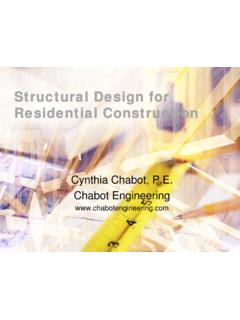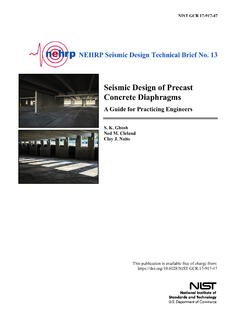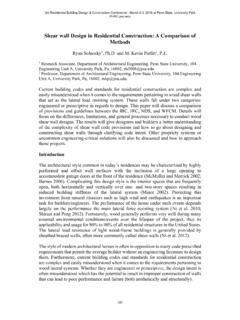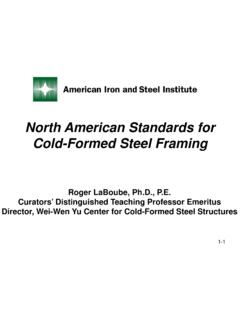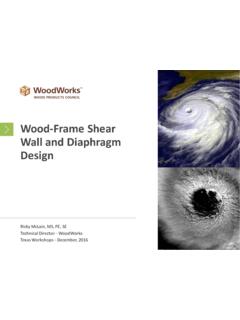Transcription of Roof Structure Design Guide - Verco Deck
1 Roof Structure Design GuidePatrick A. BodwellRoof Structure Design GuidePatrick A. BodwellVerco Decking, 2021 by Verco Decking, Inc. All rights reservedPublished by Verco Decking, Inc. Phoenix, part of this publication may be reproduced, stored in a retrieval system, or transmitted in any form or by any means, electronic, mechanical, photography, recording, scanning, or otherwise, except as permitted under Section 107 or 108 of the 1978 United States Copyright Act, without the prior written permission of the Publisher. Requests to the publisher should be directed to Verco Decking Inc., 4340 N 42nd Ave, Phoenix, AZ 85019, or through Design example is the culmination of more than a decade of effort to document a set of best practices based on conversations with steel fabricators, erectors, contractors, and engineers. Many great professionals have contributed suggestions to create the most economical solutions to solve critical Design could not have been accomplished without the input from two talented engineers, Rao Nunna, with Barnes Associates, and John Whiteman, with Vulcraft, who provided review of the drafts that led to this product.
2 John went on to offer his experience from 17 years of practice at a structural engineering firm specializing in warehouse Design to create the plans, notes, schedules, and details in the Appendix. Many of my Vulcraft and Verco teammates spent tedious hours checking the math and helping with countless editorial improvements to my writing. I do not have adequate words to express the gratitude to all of those who put so many hours in to help me get this to the finish defects that could cause injury or death may result from relying on the information in this document without independent verification by a qualified professional. The information in this document is provided AS IS . Nucor Corporation and its affiliates expressly disclaim: (i) any and all representations, warranties and conditions and (ii) all liability arising out of or related to this document and the information in , VULCRAFT, Verco , and FORMLOK are registered trademarks of Nucor. QuickFrames is a trademark of QuickFrames USA.
3 Chicago Clamp is a registered trademark of Chicago Clamp of Introduction Design Example Cold-Formed Steel Deck Calculations Codes and Reference Warehouse Building Dead Loads Deflection Criteria Seismic and Wind Building Size Limitations Area and Height Limits for Fire and Life Safety Height Limits for Structural Seismic Steel Deck Vertical Load Design Steel Deck Out-Of-Plane Design Open Web Steel Joist (OWSJ) Vertical Load Design Open Web Steel Joist Girder Vertical Load Seismic diaphragm Design Seismic Force Development diaphragm Force Coefficient Roof diaphragm Shear Load Skylight or Smoke Hatch Considerations Steel Deck diaphragm Shear Design diaphragm Chords North-South diaphragm Deflection and P-Delta Effects East-West diaphragm Seismic Wall Anchorage, Ties, and Sub-Diaphragms Wall Anchorage Force Steel Roof Deck Wall Anchorage Design and Continuous Ties Open Web Steel Joist Wall Anchorage Design and Continuous Wind diaphragm Design Main Wind Force Resisting System Loads Load Combinations diaphragm Shear Wind Loading Skylight and Smoke Hatch Considerations Wind diaphragm Design Wind diaphragm Chord Design Wind diaphragm Wind Wall Anchorage and Ties Wind Loads on Walls Loads Combinations Wall Bracing with Steel Roof Deck North-South Wall Bracing with Open Web Steel Factory Mutual Factory Mutual Data Sheets Fire Rating Steel Roof Deck Approval FM Wind Design Pressure Steel Roof Deck Design for Wind Uplift FM Steel Deck Securement to Support Framing FM Steel Roof Deck Very Large Warehouse Structures Thermal Expansion Large Single diaphragm Design High Shear Large Diaphragms with Interior Brace Frames Example Large Project Skylights, Smoke Hatches, Roof Top Mechanical Units.
4 And Misc. Roof Penetrations Skylights and Smoke Hatches Roof Top Mechanical Units Support Frames Roof Top Mechanical Unit Design Example Miscellaneous Steel Roof Deck PenetrationsAppendix Plans and Details 1271271281281291311401421451461481541581 61161162163176181 IntroductionSteel roof deck and open web steel joist is the predominate roof system in the United States for large flat roof structures. This system is the preferred choice of developers for its simplicity, strength, fire resistance, and economy. Large distribution warehouses, big-box retail, industrial and single-story commercial buildings all benefit from a steel deck and joist roof steel roof deck and joist Design example offers guidance for the Design professional based on current best practices in order to provide the best possible safe and economical steel roof deck and open web steel joist roof Structure . The combinations of products illustrated in this example may not be the optimum for every project, however the underlying methods provide a basis to optimize many other combinations of steel roof deck and Design ExampleThe Design example walks through the Design of a modest 300 ft x 504 ft warehouse Structure starting with basic fire life-safety and continuing through the structural Design of the steel roof deck and open web steel joists and girders.
5 The seismic Design of the diaphragm and wall anchorage are followed by a wind load analysis to ensure that the building Design based on seismic requirements is capable of resisting the wind loading. The resulting Design is summarized as a set of roof structural plans, notes, schedules, and details in the Mutual roof assembly considerations are applied to the example building to demonstrate the impact of Factory Mutual compliance on the Design . Factory Mutual applies wind load conditions and detailing that goes beyond the minimum life-safety requirements of the building code, with the goal of mitigating property large roof structures require additional Design considerations to distribute the Design loads and account for the effects of thermal expansion. The Design methods used for the modest Design example Structure are applied to very large roof structures in combination with consideration of thermal expansion. This will demonstrate that thermal expansion joints may be eliminated in many large roof structures through the use of a ductile steel roof diaphragm system.
6 The elimination of thermal expansion joints in the diaphragm simplifies the Design process, while providing a safer and more efficient Cold-Formed Steel Deck CalculationsThe Design example takes advantage of both Verco and Vulcraft web-based Design tools to determine the strength of the steel roof deck and open web steel joist tie plates. These web-based solutions are a large step forward from the catalogs of static load tables historically used for the Design of steel roof deck. Summary Design tool output tables are inserted in the Design example where steel deck strength is required. Readers are encouraged to utilize the web-based Design tools referenced throughout the Design example to minimize Design effort and maximize project economy by creating project specific product data sheets for their next roof Structure Codes and Reference DocumentsThis example follows the provisions of the International Building Code and referenced standards in force at the time of writing.
7 In addition, the Verco IAPMO-UES product evaluation report is used as the basis of recognition for proprietary products and Design methods. The primary reference documents used are:International Building Code (2018 IBC)American Society of Civil Engineers, Minimum Design Loads for Buildings and Other Structures (ASCE 7-16)American Iron and Steel Institute North American Specification for the Design of Cold-formed Steel Structural Members (AISI S100-16)Wind Design , 2015 Interim Revision February 2020 (FM 1-28) 2 Roof Deck Securement and Above-Deck Roof Components January, 2016 Interim Revision February 2020 (FM 1-29)Approval Standard for Profiled Steel Panels for Use as Decking in Class 1 Insulated Roof Construction, June 2012 (Class Number 4451) Verco Decking, Inc. IAPMO-UES Evaluation Report (ER-2018))Steel Deck Institute Standard for Steel Roof Deck (RD-2017)Steel Deck Institute Manual of Construction, 3rd Edition (MOC3, 2016))Steel Joist Institute Standard Specifications, 44th Edition (SJI 100-2015) Warehouse BuildingThis Design Guide addresses a typical mid-sized warehouse building, with concrete tilt-up walls, tube steel columns, open web steel joists & joist girders, and a steel deck roof diaphragm .
8 The principles applied to the Design of the roof deck for this Structure have direct parallels with similar buildings constructed with off-site pre-cast wall panels, concrete unit masonry walls, and steel (brace) frame systems. The building can be summarized as follows:Building Use: Warehouse/rack storage and/or manufacturing with optional office Structure : Steel Roof Deck supported by open web steel joists and open web steel joist girders bearing on concrete tilt-up panels and tube steel columns with a minimum 1/4 inch per foot slope to mitigate ponding Structure : Cast on-site concrete tilt-up wall Force Resisting System: Intermediate precast shear walls (bearing wall system, Reference A5 in ASCE 7 Table ) supporting a flexible steel roof deck Protection System: Automatic sprinkler Conditions: 60 foot side-yard clearance on all four sides of Warehouse BuildingThe warehouse building is based on bay sizes and framing layouts that have been proven to provide an economical balance of structural performance while providing efficient joist spacing for the automatic fire sprinkler systems.
9 The bay size for this example warehouse is 50 ft x 56 ft. The 50 ft long open web steel joists are spaced at a uniform 8 feet across the building, bearing on the 56 ft long open web steel joist girders. The roof height ranges from 32 ft to 36 ft with a 37 ft parapet height. 4 Figure Warehouse Building Plan View Figure Warehouse Building Cross Dead LoadsRoof Structure Dead Load:Roofing System + re-roof (3 psf + 2 psf) psfSteel deck psf Subtotal for Steel Deck and Roofing System psf Automatic Sprinklers psfMiscellaneous psfOpen Web Steel joists psf Subtotal for Open Web Steel Joists psf Open Web Steel Joist Girders psf Total Dead Load psf 5 Roof Structure Live LoadUniform Roof Live load psf (reducible)Concentrated Live Load 300 lbs (over a ft x ft area)Snow Load Does not apply at this siteWall Dead LoadNormal Weight Concrete 150 pcfWall Thickness 9 inchWall Weight 116 Deflection CriteriaBuilding deflection is primarily a serviceability consideration.
10 Deflections are limited for warehouse type structures to prevent damage to non-structural elements of the roof Structure deflection is due to vertical gravity and wind loads. IBC Table allows for roof structures not supporting a ceiling to deflect up to L/180, however it requires a more stringent L/240 for roof members supporting non-plaster ceilings. Many warehouse structures end up with a portion of the building containing office space with a ceiling. For this reason, a L/240 deflection limit will be set for the joists and girders that may support the future ceiling and the more liberal L/180 for the steel deck that will not support the weight of the future Joists & Girders Steel DeckLive Load Deflection Limit L/240 L/180 Wind Load Deflection Limit L/240 L/180 Seismic lateral deflection, building drift, is primarily a structural consideration. When a Structure is subject to the Design level earthquake it is acceptable for there to be damage to nonstructural elements of the Structure , provided that life safety is not compromised.

